Indian Railways
From Wikipedia, the free encyclopedia

"Lifeline to the Nation"
| |
Native name
| भारतीय रेल Bhāratīya Rail |
|---|---|
| Public sector undertaking | |
| Industry | Railways |
| Founded | 16 April 1853 [1] |
| Headquarters | New Delhi, India |
Area served
| India (also limited service toNepal, Bangladesh, Pakistan,Myanmar ) |
Key people
| |
| Services | Passenger railways Freight services Parcel carrier Catering and Tourism Services Parking lot operations Other related services |
| Revenue | |
| Profit | |
| Owner | Government of India (100%) |
Number of employees
| 1.334 million (2014)[3] |
| Parent | Ministry of Railways throughRailway Board (India) |
| Divisions | 16 Railway Zones |
| Website | www |
| Reporting mark | IR |
|---|---|
| Locale | India |
| Dates of operation | 16 April 1853–Present |
| Track gauge | 1,676 mm (5 ft 6 in) 1,000 mm (3 ft 33⁄8 in) 762 mm (2 ft 6 in) 610 mm (2 ft) |
| Headquarters | New Delhi, India |
| Website | www |
Indian Railways (reporting mark IR) is an Indian state-owned enterprise, owned and operated by the Government of India through the Ministry of Railways. It is one of the world's largest railway networks comprising 115,000 km (71,000 mi) of track over a route of 67,312 km (41,826 mi) and 7,112 stations.[3] In 2014-15, IR carried 8.397 billion passengers annually or more than 23 million passengers a day (roughly half of whom were suburban passengers) and 1.05 billion tons of freight in the year.[3] In 2014–2015 Indian Railways had revenues of ₹1.634 trillion (US$24 billion) which consists of ₹1.069 trillion (US$16 billion) from freight and₹402.80 billion (US$6.0 billion) from passengers tickets.[2]
Railways were first introduced to India in the year 1853 from Mumbai to Thane. In 1951 the systems were nationalised as one unit, the Indian Railways, becoming one of the largest networks in the world. IR operates both long distance and suburban rail systems on a multi-gauge network of broad, metre and narrow gauges. It also owns locomotive and coach production facilities at several places in India, with assigned codes identifying their gauge, kind of power and type of operation. Its operations cover twenty nine states and seven union territories and also provide limited international services to Nepal, Bangladesh and Pakistan.
Indian Railways is the world's seventh largest commercial or utility employer, by number of employees, with over 1.376 million employees as of last published figures in 2013. IR's rolling stock comprises over 245,267 Freight Wagons, 66,392 Passenger Coaches and 10,499 Locomotives (43 steam, 5,633 diesel and 4,823 electric locomotives).[3] The trains have a 5 digit numbering system and runs 12,617 passenger trains and 7,421 freight trains daily.[4] As of 31 March 2016, 27,999 km (17,398 mi) (41.59%) of the total 67,312 km (41,826 mi) route length was electrified.[5] Since 1960, almost all electrified sections on IR use 25,000 Volt AC traction through overhead catenary of delivery.
Contents
[hide]- 1History
- 2Organisational structure
- 3Railway zones
- 4Rolling stock
- 5Track and gauge
- 6Current and future developments
- 7Links to adjacent countries
- 8Types of passenger services
- 9Accommodation classes
- 10UNESCO world heritage sites
- 11Notable trains
- 12Problems and issues
- 13See also
- 14References
- 15Further reading
- 16External links
History[edit]
Main article: History of rail transport in India
The history of rail transport in India began in the mid-nineteenth century. The core of the pressure for building Railways In India came from London. In 1848, there was not a single kilometer of railway line in India. The country's first railway, built by the Great Indian Peninsula Railway(GIPR), opened in 1853, between Bombay and Thane.[6] The East Indian Railway Company was established 1 June 1845 in London by a deed of settlement with a capital of £4,000,000, largely raised in London.[7] The Great Southern India Railway Co. was founded in Britain in 1853 and registered in 1859. Construction of track in Madras Presidency began in 1859 and the 80-mile link from Trichinopoly to Negapatam was opened in 1861. The Carnatic Railway founded in 1864, opened a Madras-Arakkonam-Kancheepuram line in 1865. The Great Southern India Railway Company was subsequently merged with the Carnatic Railway Company in 1874 to form the South Indian Railway Company.[8][9]
A British engineer, Robert Maitland Brereton, was responsible for the expansion of the railways from 1857 onwards. The Allahabad-Jabalpur branch line of the East Indian Railway had been opened in June 1867. Brereton was responsible for linking this with the GIPR, resulting in a combined network of 6,400 km (4,000 mi). Hence it became possible to travel directly from Bombay to Calcutta. This route was officially opened on 7 March 1870 and it was part of the inspiration for French writer Jules Verne's book Around the World in Eighty Days. At the opening ceremony, the Viceroy Lord Mayo concluded that "it was thought desirable that, if possible, at the earliest possible moment, the whole country should be covered with a network of lines in a uniform system".[10]
By 1875, about £95 million were invested by British companies in India.[11] By 1880 the network had a route mileage of about 14,500 km (9,000 mi), mostly radiating inward from the three major port cities of Bombay, Madras and Calcutta. By 1895, India had started building its own locomotives, and in 1896, sent engineers and locomotives to help build the Uganda Railways.
In 1900, the GIPR became a government owned company. The network spread to the modern day states of Assam, Rajputhana and Madras Presidency and soon various autonomous kingdoms began to have their own rail systems. In 1905, an early Railway Board was constituted, but the powers were formally vested under Lord Curzon.[12] It served under the Department of Commerce and Industry and had a government railway official serving as chairman, and a railway manager from England and an agent of one of the company railways as the other two members. For the first time in its history, the Railways began to make a profit.
In 1907 almost all the rail companies were taken over by the government. The following year, the first electric locomotive made its appearance. With the arrival of World War I, the railways were used to meet the needs of the British outside India. With the end of the war, the railways were in a state of disrepair and collapse. Large scale corruption by British officials involved in the running of these railways companies was rampant. Profits were never reinvested in the development ofBritish colonial India.[13]
In 1920, with the network having expanded to 61,220 km (38,040 mi),[14] a need for central management was mooted by Sir William Acworth. Based on the East India Railway Committee chaired by Acworth, the government took over the management of the Railways and detached the finances of the Railways from other governmental revenues.
The period between 1920 and 1929 was a period of economic boom; there were 41,000 mi (66,000 km) of railway lines serving the country; the railways represented a capital value of some 687 million sterling; and they carried over 620 million passengers and approximately 90 million tons of goods each year.[15] Following the Great Depression, the railways suffered economically for the next eight years. The Second World War severely crippled the railways. Starting in 1939, about 40% of the rolling stock including locomotives and coaches was taken to the Middle East. The railways workshops were converted to ammunitions workshops and many railway tracks were dismantled to help the Allies in the war. By 1946, all rail systems had been taken over by the government.
Organisational structure[edit]
Main article: Indian Railway organisational structure
Railway zones[edit]
Further information: Zones and divisions of Indian Railways
Indian Railways is divided into 17 zones,[16] which are further sub-divided into divisions. The number of zones in Indian Railways increased from six to eight in 1951, nine in 1966 and sixteen in 2003.[17][18] Each zonal railway is made up of a certain number of divisions, each having a divisional headquarters. There are a total of sixty-eight divisions.[19][20]
Each zone is headed by a general manager, who reports directly to the Railway Board. The zones are further divided into divisions, under the control of divisional railway managers (DRM). The divisional officers, of engineering, mechanical, electrical, signal and telecommunication, accounts, personnel, operating, commercial, security and safety branches, report to the respective Divisional Railway Manager and are in charge of operation and maintenance of assets. Further down the hierarchy tree are the station masters, who control individual stations and train movements through the track territory under their stations' administration.
The chart below briefly depicted the Indian Railway's zones, Route Km, electrified route, number of stations and divisions.
Recruitment and training[edit]
Main article: Centralised Training Institutes of the Indian Railways
Staff are classified into gazetted (Group 'A' and 'B') and non-gazetted (Group 'C' and 'D') employees.[23] The recruitment of Group 'A' gazetted employees is carried out by the Union Public Service Commission through exams conducted by it.[24] The Recruitment of Group 'B' for the following post Section Officers,Junior Engineers,Depot Material Superintendent posts is conducted by Railway Recruitment board.[25] The recruitment to Group 'C' and 'D' employees on the Indian Railways is done through 21 Railway Recruitment Boards and Railway Recruitment Cells which are controlled by the Railway Recruitment Control Board (RRCB).[26] The training of all cadres is entrusted and shared between six centralised training institutes.
Indian Railways recruits for lower level positions like ASM, Goods Guard, Clerk, TA, CA, JE, Staff Nurse, Group D etc. through it RRB NTPC (Railway Recruitment Board Non Technical ) examination. For year 2016, the examination was conducted to recruit around 18,000 positions.[27]
.
Rolling stock[edit]
Locomotives[edit]
Main article: Locomotives in India
Locomotives in India consist of electric and diesel locomotives. The world's first CNG (Compressed Natural Gas) locomotives are also being used.[28] Steam locomotives are no longer used, except in heritage trains. In India, locomotives are classified according to their track gauge, motive power, the work they are suited for and their power or model number. The class name includes this information about the locomotive. It comprises 4 or 5 letters. The first letter denotes the track gauge. The second letter denotes their motive power, Diesel or Alternating current (Electric), and the third letter denotes the kind of traffic for which they are suited (goods, passenger, Multi or shunting). The fourth letter used to denote locomotives' chronological model number. However, from 2002 a new classification scheme has been adopted. Under this system, for newer diesel locomotives, the fourth letter will denote their horsepower range. Electric locomotives don't come under this scheme and even all diesel locos are not covered. For them this letter denotes their model number as usual.
A locomotive may sometimes have a fifth letter in its name which generally denotes a technical variant or subclass or subtype. This fifth letter indicates some smaller variation in the basic model or series, perhaps different motors, or a different manufacturer. With the new scheme for classifying diesel locomotives (as mentioned above) the fifth item is a letter that further refines the horsepower indication in 100 hp increments: 'A' for 100 hp, 'B' for 200 hp, 'C' for 300 hp, etc. So in this scheme, a WDM-3A refers to a 3100 hp loco, while a WDM-3D would be a 3400 hp loco and WDM-3F would be 3600 hp loco.
Note: This classification system does not apply to steam locomotives in India as they have become non-functional now. They retained their original class names such as M class or WP class.
Diesel Locomotives are now fitted with Auxiliary Power Units which saves nearly 88% of Fuel during the idle time when train is not running.[29]
Goods wagons
The number of goods wagons was 205,596 on 31 March 1951 and reached the maximum number 405,183 on 31 March 1980 after which it started declining and was 239,321 on 31 March 2012. The number is far less than the requirement and the Indian Railways keeps losing freight traffic to road. Indian Railways carried 93 million tonnes of goods in 1950–51 and it increased to 1010 million tonnes in 2012–13.[30]
However, its share in goods traffic is much lower than road traffic. In 1951, its share was 65% and the share of road was 35%. Now the shares have been reversed and the share of railways has declined to 30% and the share of road has increased to 70%.
Passenger coaches
Indian railways has several types of passenger coaches.
The coaches used in Indian Railways are produced at Integral Coach Factory, Rail Coach Factory; including the new LHB coaches.
Passenger coaches numbered 46,722 on 31 March 2012. Other coaches (luggage coach, parcel van, guard's coach, mail coach, etc.) numbered 6,560 on 31 March 2012.
Electric Multiple Unit (EMU) coaches are used for suburban traffic in large cities – mainly Mumbai, Chennai, Delhi, Kolkata, Pune,Hyderabad and Bangalore. These coaches numbered 7,793 on 31 March 2012. They have second class and first class seating accommodation.
Freight[edit]
Indian Railways earns about 70% of its revenues from freight traffic (₹686.2 billion from freight and ₹304.6 billion from passengers in 2011–12). Most of its profits come from transporting freight, and this makes up for losses on passenger traffic. It deliberately keeps its passenger fares low and cross-subsidises the loss-making passenger traffic with the profit-making freight traffic.
Since the 1990s, Indian Railways has stopped single-wagon consignments and provides only full rake freight trains
Wagon types include:[31]
- BOXNHL
- BOBYN
- BCN
- BCNHL
Track and gauge
Indian railways uses four gauges, the 1,676 mm (5 ft 6 in) broad gauge which is wider than the 1,435 mm (4 ft 81⁄2 in) standard gauge; the1,000 mm (3 ft 33⁄8 in) metre gauge; and two narrow gauges, 762 mm (2 ft 6 in) and 610 mm (2 ft). Track sections are rated for speeds ranging from 80 to 200 km/h (50 to 124 mph).Though trains don't really clock speeds of 200 km/h.
The total length of track used by Indian Railways is about 115,000 km (71,000 mi) while the total route length of the network is 67,312 km (41,826 mi).About 27,999 km (17,398 mi) or 42% of the route-kilometre was electrified, as of 31 March 2016.
Broad gauge is the predominant gauge used by Indian Railways. Indian broad gauge—1,676 mm (5 ft 6 in)—is the most widely used gauge in India with 108,500 km (67,400 mi) of track length (94% of entire track length of all the gauges) and 59,400 km (36,900 mi) of route-kilometre (91% of entire route-kilometre of all the gauges).
In some regions with less traffic, the metre gauge (1,000 mm (3 ft 33⁄8 in)) is common, although the Unigauge project is in progress toconvert all tracks to broad gauge. The metre gauge has about 5,000 km (3,100 mi) of track length (4% of entire track length of all the gauges) and 4,100 km (2,500 mi) of route-kilometre (7% of entire route-kilometre of all the gauges).
The Narrow gauges are present on a few routes, lying in hilly terrains and in some erstwhile private railways (on cost considerations), which are usually difficult to convert to broad gauge. Narrow gauges have 1,500 route-kilometre. The Kalka-Shimla Railway, the Kangra Valley Railway and the Darjeeling Himalayan Railway are three notable hill lines that use narrow gauge, but the Nilgiri Mountain Railway is a metre gauge track.[32] These four rail lines will not be converted under the Unigauge project.
The share of broad gauge in the total route-kilometre has been steadily rising, increasing from 47% (25,258 route-km) in 1951 to 86% in 2012 whereas the share of metre gauge has declined from 45% (24,185 route-km) to 10% in the same period and the share of narrow gauges has decreased from 8% to 3%. About 27,999 route-km of Indian railways is electrified.
Sleepers (ties) are made up of prestressed concrete, or steel or cast iron posts, though teak sleepers are still in use on a few older lines. The prestressed concrete sleeper is in wide use today. Metal sleepers were extensively used before the advent of concrete sleepers. Indian Railways divides the country into four zones on the basis of the range of track temperature. The greatest temperature variations occur in Rajasthan.
Research and development
Indian Railways has a full-fledged organisation known as Research Designs and Standards Organisation (RDSO), located at Lucknow for all research, designs and standardisation tasks.
In August 2013, Indian Railways entered into a partnership with Indian Institute of Technology (Madras) to develop technology to tap solar energy for lighting and air-conditioning in the coaches. This would significantly reduce the fossil fuel dependency for Indian Railways.[33]
Recently it developed and tested the Improved Automated Fire Alarm System in Rajdhani Express Trains. It is intended that the system be applied to AC coaches of all regular trains.[34]
Current and future developments
Main article: Future of the Indian Railways
In recent years, Indian Railways has undertaken several initiatives to upgrade its ageing infrastructure and enhance its quality of service. The Indian government plans to invest ₹9.05 trillion (US$130 billion) to upgrade the railways by 2020.[35] Indian Railways is refurbishing 12-15 year old coaches at Carriage Rehabilitation Workshop in Bhopal to enhance passenger amenities and fire safety measures.[36][37]
Bio-Toilets on railways[edit]
The bio-toilets, which have been developed by the railways and the Defence Research and Development Organisation (DRDO), have a colony of anaerobic bacteria, kept in a container under the lavatories that convert human waste into water and small amounts of gases. The gases are released into the atmosphere and the water is discharged after chlorination on to the track. The railways currently uses flush toilets in trains, in which human waste is dumped directly on the track. This makes the environment unhygienic and railway stations an eyesore, apart from the fact that the faecal matter corrodes the tracks.
Southern Railways officials say that except for the first- and two-tier AC coaches of Uzhavan Express, the remaining 34 coaches have been fitted with bio-toilets. "These toilets aim at zero defecation on the ground," says Vinay Srivastava, former director-in-charge of the bio-toilet project who is currently working as director, Ministry of Environment and Forests.
More bio-toilets have been fitted into coaches this year[clarification needed]than the total bio-toilets fitted in the last three years. According to an IR source, the number of bio-toilets fitted in passenger train coaches from April to July this year was 2,285, against 1,337 bio-toilets fitted during 2012-13, 169 during 2011-12, and 57 during 2010-11.
Locomotive factories
In 2015, plans were disclosed for building two locomotive factories in the state of Bihar, at Madhepura (diesel locomotives) and at Marhowra (electric locomotives). Both factories involve foreign partnerships. The diesel locomotive works will be jointly operated in a partnership with General Electric, which has invested ₹20.52 billion (US$300 million) for its construction, and the electric locomotive works with Alstom, which has invested ₹12.935 billion (US$190 million). The factories will provide Indian Railways with 800 electric locomotives of 12,000 horse power each, and a mix of 1,000 diesel locomotives of 4,500 and 6,000 horsepower each.[38] In November 2015, further details of the ₹146.56 billion(US$2.2 billion) partnership with GE were announced: Indian Railways and GE would engage in an 11-year joint venture in which GE would hold a majority stake of 74%. Under the terms of the joint venture, Indian Railways would purchase 100 goods locomotives a year for 10 years beginning in 2017; the locomotives would be modified versions of theGE Evolution series.[39] The diesel locomotive works will be built by 2018; GE will import the first 100 locomotives and manufacture the remaining 900 in India from 2019, also assuming responsibility for their maintenance over a 13-year period.[40] In the same month, a ₹200 billion (US$3.0 billion) partnership with Alstom to supply 800 electric locomotives from 2018 to 2028 was announced.
Links to adjacent countries]
Existing rail links:
- Nepal – Break-of-gauge – Gauge conversion under uni-gauge project
- Pakistan – same Broad Gauge. Thar Express to Karachi and the more famous Samjhauta Express international train from Lahore, Pakistan to Amritsar (Attari).
- Bangladesh – Same Broad Gauge. The Maitree Express between Dhaka and Kolkata started in April 2008 using the Gede-Darsana route, in addition to a Freight Train service from Singhabad and Petrapole in India to Rohanpur and Benapole in Bangladesh. A second passenger link between Agartala, India and Akhaura Upazila, Bangladesh was approved by the Government of Bangladesh and India in September 2011.
Under construction / Proposed links:
- Bhutan – Railways Under Construction – Same gauge
- Myanmar – Manipur to Myanmar (under construction)
- Vietnam – On 9 April 2010, Former Union Minister of India, Shashi Tharoor announced that the central government is considering a rail link from Manipur to Vietnam viaMyanmar.
- Thailand – possible if Burma Railway is rebuilt.
Types of passenger services
Trains are classified by their average speed. A faster train has fewer stops ("halts") than a slower one and usually caters to long-distance travel.
| S.no | Train | Description |
|---|---|---|
| 1 | Gatimaan Express | It is a semi high speed train that runs between Delhi and Agra in India. It operates at a speed of 160 km/h (99 mph) and is one of the fastest train in India. The train will take a travel time of 100 minutes to cover 188 km (117 mi) journey from Hazrat Nizamuddin to Agra Cantonment railway stations. |
| 2 | Shatabdi Express | The Shatabdi trains are air-conditioned, intercity trains for travel during daytime. Unlike the Rajdhani or Duronto Expresses, all Shatabdi expresses, it makes a round trip on same day. The Bhopal Shatabdi Express (Train no: 12001/12002) is the fastest train in India, between New Delhi and Agra cantonment, this train travels at an average speed of 100 km/h (62 mph) and touches top speed of 160 kilometres per hour (99 mph). They have seats and executive class seats, Some also have 3-tier AC berth. They have limited stops. Indian Railway is planning to introduce Wi-Fi services, New Delhi - Kalka Shatabdi Express being first train for trials.[45] |
| 3 | Rajdhani Express | These are air-conditioned trains linking major cities to New Delhi. They have high priority and are one of the fastest trains in India, travelling at a maximum speed of around 130–140 km/h (81–87 mph). They have limited stops. In the Railway budget of 2014, it was proposed that the speed of Rajdhani express, and Shatabdi Expresses would be increased up 180 km/h (110 mph). |
| 4 | Duronto Express | These are the non-stop (except for technical halts) point to point rail services introduced for the first time in 2009. They connect the metros and major state capitals of India and were introduced to travel as fast or faster than the Rajdhani Express. They provide first AC, two-tier AC and three-tier AC accommodation. Some of them provide non air-conditioned Sleeper Class accommodation. |
| 5 | AC Express | These are fully air-conditioned trains linking major cities in the country. They have high priority and are one of the fastest trains in India, travelling at about 130 km/h (81 mph). They have limited stops. |
| 6 | Tejas Express | Same as Shatabdi Express, these are fully air-conditioned single floor express trains. They have high priority and have limited stops. But unlike the Shatabdi Express these trains are sleeper trains used for long distance hauling. |
| 7 | Double Decker Express | Same as Shatabdi Express, these are fully air-conditioned two floor express trains. They have high priority and are among fast trains in India. They have limited stops. These trains are used for daytime travel. |
| 8 | Uday Express | Same as Double Decker Express, these are fully air-conditioned two floor express trains. They have high priority and have limited stops. These trains have berth facility and are used for night travel. |
| 9 | Jan Shatabdi Express | Jan Shatabdi Express are more affordable variety of the Shatabdi Express, which have both AC and non-AC classes. The maximum speed is 130 km/h (81 mph). They have fewer stops. |
| 10 | Garib Rath | Air-conditioned no-frills trains with seats and 3-tier Economy AC berths. The maximum speed is 130 km/h (81 mph). Some of them have AC Chair cars also. |
| 11 | Humsafar Express | These are fully AC 3 tier coaches trains. |
| 12 | Sampark Kranti Express | These are a series of trains which provide super fast Express-like connectivity to the national capital Delhi. These trains have higher priority than Super Express / Mail. |
| 13 | Yuva Express | These trains were started along with Duronto Express trains to provide air conditioned travel to youth of the country. Sixty percent of the seats of these trains were reserved for passengers between 18 – 45 years of age. These trains did not enjoy much success. Today these trains only operate on the Delhi - Howrah and Delhi - Mumbai routes. |
| 14 | Kavi Guru Express | These trains were introduced in honor of Rabindranath Tagore. Currently four pairs of these trains operate on the Indian Railways network. |
| 15 | Vivek Express | These trains were introduced to commemorate the 150th birth Anniversary of Swami Vivekananda in 2013. Currently four pairs of Vivek Express run in the country. |
| 16 | Superfast Express/Mail | These trains travel at a speed greater than 100–110 km/h (62–68 mph). Tickets for these trains have an additional superfast surcharge. |
| 17 | Intercity Express | These trains were introduced to connect important cities for short routes. These appear in both Superfast Express speed and Express speed category. Some of the famous legendary Intercity Express are Deccan Queen and Flying Ranee. |
| 18 | Rajya Rani Express | These trains were introduced to connect state capitals to important cities in that state. |
| 19 | Express/Mails | These are the most common kind of trains in India. They have more stops than their super-fast counterparts, but they stop only at relatively important intermediate stations. |
| 20 | Fast PassengerandPassenger | These are slow trains that stop at most or every station along the route and are the cheapest trains. The trains generally have unreserved seating accommodation but some night trains have sleeper and 3-tier AC compartments. These trains travel at about 40–80 km/h (25–50 mph). |
| 21 | Suburban trains | These trains operate in the urban areas of Mumbai, Delhi, Kolkata, Chennai, Hyderabad, Ahmedabad, Pune and between Kanpur and Lucknow, usually stop at every stations and have unreserved seating accommodation. |
| 22 | Metro | These trains are designed for city transport. Indian Railway constructed the first Kolkata Metro for the city of Kolkata. Now metro railway services are found in New Delhi, Mumbai and Bangalore also. |
| 23 | Antyodaya and Jan Sadharan Express | These are fully non reserved trains. Antyodaya Express operates on peak routes. These trains are run to reduce the pressure on other trains on that route. |
| 24 | Mahamana Express | It is the new version of coaches of Indian Railways with modern benefits and facilities. The livery of the train is also different from other train. It is a tri-weekly superfast train service which runs between the city of Varanasi and New Delhi via Jaunpur, Sultanpur, Lucknow and Moradabad. |
| 25 | Tourist Trains | Indian Railways also operate luxurious tourist trains like Palace on Wheels, Maharaja Express, The Golden Chariot, Royal Rajasthan on Wheels etc. Fairy Queen has also gained tourist attraction because it is the oldest steam engine in operation hauling a luxurious train from Delhi to Alwar. |
| 26 | Heritage Trains | Darjeeling Himalayan Railway: The Darjeeling Himalayan Railway, also known as the "Toy Train", is a 2 ft (610 mm) narrow gauge railway that runs between New Jalpaiguri and Darjeeling in the Indian state of West Bengal, India. Built between 1879 and 1881. DHR was declared a World Heritage site by UNESCO in 1999. |
Accommodation classes
Main article: Indian Railways coaching stock
Indian Railways has several classes of travel with or without airconditioning. A train may have just one or many classes of travel. Slow passenger trains have only unreserved seating class whereas Rajdhani, Duronto, Shatabdi, garib rath and yuva trains have only airconditioned classes. The fares for all classes are different with unreserved seating class being the cheapest. The fare of Rajdhani, Duronto and Shatabdi trains includes food served in the train but the fare for other trains does not include food that has to be bought separately. In long-distance trains a pantry car is usually included and food is served at the berth or seat itself. Luxury trains such as Palace on Wheels have separate dining cars but these trains cost as much as or more than a five-star hotel room.
A standard passenger rake generally has four unreserved (also called "general") compartments, two at the front and two at the end, of which one may be exclusively for ladies. The exact number of other coaches varies according to the demand and the route. A luggage compartment can also exist at the front or the back. In some mail trains a separate mail coach is attached. Lavatories are communal and feature both the Indian style as well as the Western style.
The following table lists the classes in operation. A train may not have all these classes.
| Class[46] | Description[46][47] |
|---|---|
| 1A | First class AC: This is the most expensive class, where the fares are almost at par with air fare. There are eight cabins (including two coupes) in the full AC First Class coach and three cabins (including one coupe) in the half AC First Class coach. The coach has an attendant to help the passengers. Bedding is included with the fare in IR. This air conditioned coach is present only on popular routes and can carry 18 passengers (full coach) or 10 passengers (half coach). The sleeper berths are extremely wide and spacious. The coaches are carpeted, have sleeping accommodation and have privacy features like personal coupes. This class is available on broad gauge and metre gauge trains. |
| 2A | AC-Two tier: These air-conditioned coaches have sleeping berths across eight bays. Berths are usually arranged in two tiers in bays of six, four across the width of the coach and two berths longways on the other side of the corridor, with curtains along the gangway or corridor. Bedding is included with the fare. A broad gauge coach can carry 48 passengers (full coach) or 20 passengers (half coach). This class is available on broad gauge and metre gauge trains. |
| FC | First class: Same as 1AC but without air conditioning. No bedding is available in this class. The berths are wide and spacious. There is a coach attendant to help the passengers. This class has been phased out on most of the trains and is rare to find. However narrow gauge trains to hill stations have this class. |
| 3A | AC three tier: Air conditioned coaches with 64 sleeping berths. Berths are usually arranged as in 2AC but with three tiers across the width and two longways as before giving eight bays of eight. They are slightly less well-appointed, usually no reading lights or curtained off gangways. Bedding is included with fare. It carries 64 passengers in broad gauge. This class is available only on broad gauge. |
| 3E | AC three tier (Economy): Air conditioned coaches with sleeping berths, present in Garib Rath Trains. Berths are usually arranged as in 3AC but with three tiers across the width and three longways. They are slightly less well-appointed, usually no reading lights or curtained off gangways. Bedding is not included with fare. |
| CC | AC chair car: An air-conditioned seater coach with a total of five seats in a row used for day travel between cities. |
| EC | Executive class chair car: An air-conditioned coach with large spacious seats and legroom. It has a total of four seats in a row used for day travel between cities. This class of travel is only available on Shatabdi Express trains. |
| Double Decker | Double Decker: These are found in both AC and Non-AC rakes. AC Double Deck sitter coaches used in Double Decker Express. AC Double Deck sleeper will be used by newly proposed Uday Express. Non-AC Double Deck sitter were introduced to few Mumbai-Pune trains and the Flying Ranee. However Flying Ranee is the only train that uses Non-AC Double Decker sitter coaches. |
| SL | Sleeper class: The sleeper class is the most common coach on IR, and usually ten or more coaches could be attached. These are regular sleeping coaches with three berths vertically stacked. In broad gauge, it carries 72 passengers per coach. |
| 2S | Seater class: same as AC Chair car, without the air-conditioning. These may be reserved in advance or may be unreserved. |
| UR/GEN | Unreserved/General: The cheapest accommodation. The seats are usually made up of pressed wood in older coaches but cushioned seats are found in new coaches. These coaches are usually over-crowded and a seat is not guaranteed. Tickets are issued in advance for a minimum journey of more than 24 hours. Tickets issued are valid on any train on the same route if boarded within 24 hours of buying the ticket. |
| Deen Dayalu | Deen Dayalu: These are non reserved coaches for long distance trains. |
At the rear of the train is a special compartment known as the guard's cabin. It is fitted with a transceiver and is where the guard usually gives the all clear signal before the train departs.
UNESCO world heritage sites[
There are two UNESCO World Heritage Sites on Indian Railways. – The Chatrapati Shivaji Terminus and the Mountain Railways of India. The latter consists of three separate railway lines located in different parts of India:[49]
- Darjeeling Himalayan Railway, a narrow gauge railway in West Bengal.
- Nilgiri Mountain Railway, a 1,000 mm (3 ft 33⁄8 in) metre gauge railway in the Nilgiri Hills in Tamil Nadu.
- Kalka-Shimla Railway, a narrow gauge railway in the Shivalik mountains in Himachal Pradesh. In 2003 the railway was featured in theGuinness Book of World Records for offering the steepest rise in altitude in the space of 96 kilometer.
Notable trains
Tourist trains
- Palace on Wheels is a specially designed luxury tourist train service, frequently hauled by a steam locomotive, for promoting tourism inRajasthan.[51] The train has a 7 nights & 8 days itinerary, it departs from New Delhi (Day 1), and covers Jaipur (Day 2), Sawai Madhopur and Chittaurgarh (Day 3), Udaipur (Day 4), Jaisalmer (Day 5), Jodhpur (Day 6), Bharatpur and Agra (Day 7), return to Delhi (Day 8).
- Royal Rajasthan on Wheels a luxury tourist train service covers various tourist destinations in Rajasthan. The train takes tourists on a 7-day/8-night tour through Rajasthan. The train starts from New Delhi's Safdarjung railway station (Day 1), and has stops at Jodhpur(Day 2), Udaipur and Chittaurgarh (Day 3), Ranthambore National Park and Jaipur (Day 4), Khajuraho (Day 5), Varanasi and Sarnath(Day 6), Agra (Day 7) and back to Delhi (Day 8).
- Maharaja Express a luxury train operated by IRCTC runs on five circuits covering more than 12 destinations across North-West and Central India, mainly centered around Rajasthan between the months of October to April.
- Deccan Odyssey luxury tourist train service covers various tourist destinations in Maharashtra and Goa. The 7 Nights / 8 Days tour starts from Mumbai (Day 1) and covers Jaigad Fort, Ganapatipule and Ratnagiri (Day 2), Sindhudurg, Tarkarli and Sawantwadi (Day 3), Goa (Day 4), Kolhapur and Pune (Day 5), Aurangabad and Ellora Caves (Day 6), Ajanta Caves and Nashik (Day 7), and back toMumbai (Day 8)
- The Golden Chariot luxury train runs on two circuits Pride of the South[ and Splendor of the South.
- Mahaparinirvan Express an a/c train service also known as Buddhist Circuit Train which is run by IRCTC to attract Buddhist pilgrims. The 7 nights/8 Days tour starts from New Delhi (Day 1) and covers Bodh Gaya (Day 2), Rajgir and Nalanda (Day 3), Varanasi andSarnath (Day 4), Kushinagar and Lumbini (Day 5 and 6), Sravasti (Day 7), Taj Mahal (Agra) (Day 8) before returning to New Delhi on (Day 8).]
Other trains
- Samjhauta Express is a train that runs between India and Pakistan. However, hostilities between the two nations in 2001 saw the line being closed. It was reopened when the hostilities subsided in 2004. Another train connecting Khokhrapar (Pakistan) and Munabao(India) is the Thar Express that restarted operations on 18 February 2006; it was earlier closed down after the 1965 Indo-Pak war.
- Lifeline Express is a special train popularly known as the "Hospital-on-Wheels" which provides healthcare to the rural areas. This train has a carriage that serves as an operating room, a second one which serves as a storeroom and an additional two that serve as a patient ward. The train travels around the country, staying at a location for about two months before moving elsewhere.
- Fairy Queen is the oldest operating locomotive in the world today, though it is operated only for specials between Delhi and Alwar.John Bull, a locomotive older than Fairy Queen, operated in 1981 commemorating its 150th anniversary. Gorakhpur railway station also has the distinction of being the world's longest railway platform at 4,483 ft (1,366 m). The Ghum station along the Darjeeling Toy Train route is the second highest railway station in the world to be reached by a steam locomotive.[58] The Mumbai–Pune Deccan Queen has the oldest running dining car in IR.
- Vivek Express, between Dibrugarh and Kanyakumari, has the longest run in terms of distance and time on Indian Railways network. It covers 4,286 km (2,663 mi) in about 82 hours and 30 minutes.
- 12049/12050 Hazrat Nizamuddin - Agra Cantt. Gatimaan Express is the fastest train of India having a maximum speed of 160 km/h and average speed of 112 km/h. 12001/12002 Bhopal Shatabdi Express was the fastest train in India having a maximum speed of 150 km/h on the Faridabad–Agra section. The fastest speed attained by any train is 184 km/h (114 mph) in 2000 during test runs.
- Special Trains are those trains started by Indian Railways for any specific event or cause which includes Jagriti Yatra trains,[59] Kumbh Mela Trains.,[60] emergency trains, etc.
- Double-decker AC trains have been introduced in India. The first double decker train was Pune-Mumbai Sinhagad express plying between Pune and Mumbai[62] while the first double-decker AC train in the Indian Railways was introduced in November 2010, running between the Dhanbad and Howrah stations having 10 coaches and 2 power cars.[63] On 16 April 2013, Indian Railways celebrated its 160 years of nationwide connectivity with a transportation of 23 million passengers in a day.[64]
Problems and issues
Indian Railways is cash strapped and reported a loss of ₹300 billion (US$4.5 billion) in the passenger segment for the year ending March 2014. Operating ratio, a key metric used by Indian railways to gauge financial health, is 91.8% in the year 2014–15. Railways carry a social obligation of over ₹200 billion (US$3.0 billion). The loss per passenger-km increased to 23 paise (0.34¢ US) by the end of March 2014. Indian Railways is left with a surplus cash of just ₹6.9 billion (US$100 million) by the end of March 2014.
It was estimated in 2014 that over ₹5 trillion (US$74 billion) is required to complete the ongoing projects alone. The railway is consistently losing market share to other modes of transport both in freight and passengers.
New railway line projects are often announced during the Railway Budget annually without securing additional funding for them. Between 2004 and 2014, 99 New Line projects worth ₹600 billion (US$8.9 billion) were sanctioned out of which only one project is complete till date, and there are four projects that are as old as 30 years, but are still not complete for one reason or another.
See also
- Rail transport in India
- High-speed rail in India
- Rapid transit in India
- List of railway stations in India
- List of named passenger trains of India
- List of longest train services in India
- List of countries by rail transport network size
- All India Station Masters' Association (AISMA)
- Tatkal Scheme
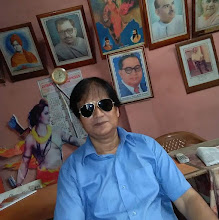



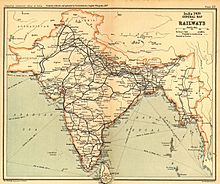




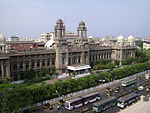




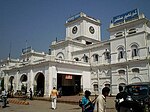

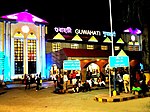





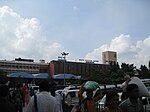

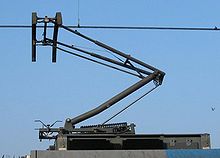

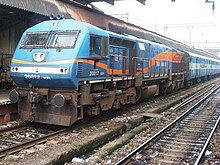






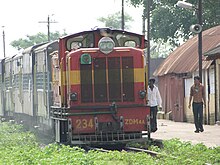
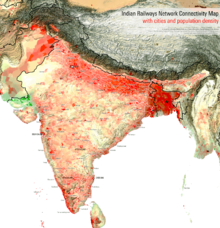


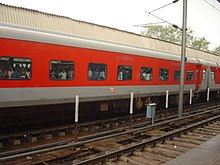
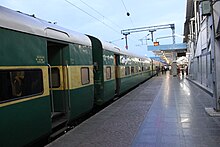
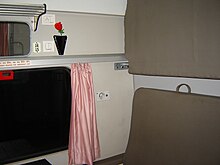

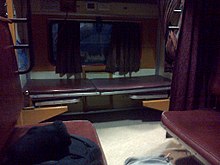
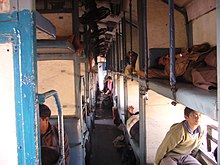
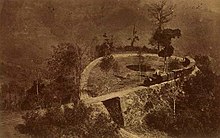

No comments:
Post a Comment